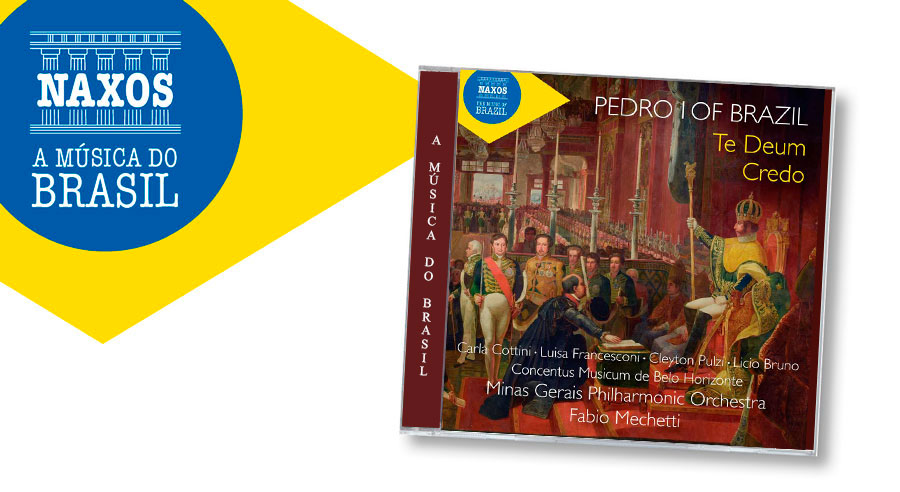
PEDRO I OF BRAZIL
Carla Cottini – soprano / Luisa Francesconi – mezzo soprano / Cleyton Pulzi – tenor / Licio Bruno – baixo
Concentus Musicum de Belo Horizonte
Orquestra Filarmônica de Minas Gerais
Fabio Mechetti – regente
As celebrações pelo bicentenário da Independência têm chamado atenção a um aspecto normalmente pouco abordado da trajetória de d. Pedro I: seu trabalho como compositor. Ele foi alunos de dois dos mais importantes compositores de sua época, Marcos Portugal e Sigismund Neukomm. Escreveu cerca de vinte obras ainda hoje conhecidas – e acredita-se que o número possa ser bem maior. Em meio a essa produção, duas obras merecem destaque: Credo e Te Deum. E ambas foram gravadas para a coleção Música do Brasil, projeto do selo Naxos em parceria com o Ministério das Relações Exteriores brasileiro, no primeiro semestre deste ano. O registro contou com a Orquestra Filarmônica de Minas Gerais, um time especial de solistas e o Concentus Musicum, com regência do maestro Fabio Mechetti. O Te Deum não apenas revela o talento musical do imperador, mas também como ele foi fruto de sua época: a partitura, escrita para o batismo de seu primeiro filho, tem caráter bastante operístico, à medida em que o gênero ganhava força no país. Já o Credo é marcado por enormes lirismo e vivacidade, características que a orquestra mineira sabe recriar com desenvoltura, senso de estilo e verve.
Clique AQUI para comprar na Loja CLÁSSICOS
Clique AQUI para ouvir no Spotify
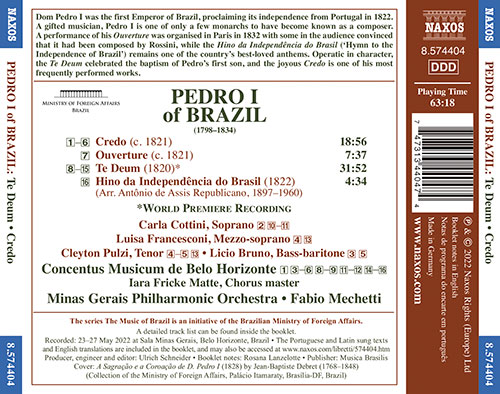
Texto do encarte do CD
Pedro I (1798–1834): Te Deum • Credo
Dom Pedro, fourth son of Prince João of Portugal and his wife Carlota Joaquina of Spain, was born in Lisbon on 12 October 1798. His musical talent was inherited from his Braganza ancestors, among them João IV (1604–1656), who was himself a composer and amassed the largest music library of its time in Europe. Pedro's father, the future João VI, appreciated music above all other art forms, and arranged for his son to be taught by the most famous Portuguese composer of the time, Marcos Portugal (1762–1830).
In 1808, the nine-year-old Pedro sailed to Brazil with the entire Portuguese court as it made a strategic retreat from the advancing Napoleonic forces. Marcos Portugal arrived three years later, in 1811, and resumed his teaching duties with the royal princes, for whose lessons he transcribed arias from his most famous operas.
According to contemporary sources, Pedro was a gifted singer and conductor, and played the piano, flute, clarinet, violin, double bass, trombone, harp and guitar. He received his earliest composition lessons from Haydn's favourite pupil, Sigismund von Neukomm (1778–1858), who reached Rio de Janeiro in 1816. In November of the same year, the Austrian composer made reference in his catalogue to fantasias inspired by waltzes written by Pedro, works that so far remain lost.
After proclaiming Brazil's independence on 7 September 1822, the prince ruled the country as Pedro I until April 1831, when he abdicated in favour of his son, Pedro II (1825–1891). Following the death of João VI, he had also briefly been King of Portugal, as Pedro IV, but here too had abdicated, in this case in favour of his eldest daughter, Maria da Glória (1819–1853).
Pedro died on 24 September 1834, aged 35, a few months after the end of the war he had waged to restore Maria to the throne, which had been usurped by his brother Dom Miguel. Having freed Portugal from the threat of absolutism, he re-established a constitutional monarchy, for which reason he became known as 'the Liberator'.
Although many monarchs have been performers or music lovers, few are known as composers. Matters of state and, of course, a premature death, prevented Pedro I from building a large catalogue. In terms of scale, the most significant of his works are the Masses and his Te Deum, and he is also remembered for two patriotic songs – the Hino da Independência ('Independence Anthem') and the Hino da Carta ('Constitution Anthem'). The latter, which appeared in several publications of the day, was the official national anthem of Portugal between May 1834, when the war against Prince Miguel ended, and the proclamation of the First Portuguese Republic in 1910.
Credo
One of Pedro's most frequently performed works, this setting is known as the Credo do Emperador ('Emperor's Credo'), this being the title of the manuscript volume archived in the Metropolitan Cathedral of Rio de Janeiro which, as well as the Credo, contains the Sanctus and Agnus Dei movements of Pedro's Missa de Nossa Senhora do Carmo ('Mass of Our Lady of Mount Carmel'). A copy of the Credo was recently located in the Cathedral of Angra do Heroísmo in the Azores, as part of a bound volume entitled Obras de D. Pedro ('Works by Dom Pedro').
In November 1821, giving some clues as to the dates of these works, the Gazeta do Rio de Janeiro reported on a performance of the 'Music of the Mass and Te Deum' by Dom Pedro – in all likelihood including the Credo – at the church of São Francisco de Paula. The music was 'conducted by Father José Maurício Nunes Garcia, Master of the Royal Chapel, and performed by all the musicians of the Chapel'.
Ouverture
The Ouverture has survived in a manuscript copy housed in the archives of the Orquestra Lira Sanjoanense, in São João del Rey, one of the towns on the 'gold route' that led from Minas Gerais to Rio de Janeiro. The work is in E flat major, a key signature favoured by freemasons because its three flats form a triangle on the stave, symbolising the Trinity or the three stages of Masonic initiation: apprentice, journeyman and master mason. Dom Pedro's liberal ideas were in line with masonic and Enlightenment ideals, and he was installed as Grand Master of the Grand Orient of Brazil on 4 October 1822.
While he was in Paris in 1832, raising funds and organising troops to fight against his brother's armies, Pedro frequently attended performances at the Théâtre Italien. There he met Rossini (1792–1868), who was then director of the opera house and who asked the royal composer if he had a score that could be performed there. Writing to Pedro's son, Emperor Pedro II, years later (April 1866), Rossini mentioned this event:
'During the all too brief stay of His Majesty the Emperor Dom Pedro in Paris, I arranged the performance at the Théâtre Italien of a charming overture which he had written. It was a great success, and since, for reasons of discretion, I did not name the composer, a number of compliments came my way, maybe in the belief that I myself had written the aforementioned overture. That error will not displease his august son, who might perhaps, in his memory, send me a little of his country's justly celebrated coffee.'
The Ouverture was most likely written in 1821 and remains the only orchestral work by Pedro I to have been discovered to date. The work is sometimes referred to as Independence Overture, but the authenticity of that name is disputed.
Te Deum
The autograph manuscript of the Te Deum, composed in late 1820, bears the following unfinished dedication: 'Te Deum laudamus for four voices and large orchestra presented to King João by his Son the Royal Prince Pedro d'Alcântara, Duke of Braganza, who composed it for the birth ...' This suggests that the text should have been completed with the date of birth of the future heir to the throne, Dom Pedro's eldest son, Dom João Carlos: 6 March 1821. And in fact we know from a report in the Gazeta do Rio de Janeiro that a Te Deum by Pedro was performed in the Royal Chapel on the occasion of the young prince's baptism on 27 March 1821, conducted by Marcos Portugal.
Shortly before this, in February 1821, Pedro's wife Leopoldina had written to her father Francis I (emperor of Austria): 'My husband, who is also a composer, sends you a Missa solemnis, Sinfonia and Te Deum he himself has written; to speak frankly, the music is a little theatrical, which is the fault of its composer, but I can promise you that he had no help at all in writing it.' These scores have yet to be rediscovered in Austria, but given the date of the letter, it is plausible that Leopoldina was referring to the same Te Deum.
Her veiled criticism of Pedro's style reflects how alien northern Europeans found the customs of the Portuguese court, for whom church was a place of celebration, and its services occasions for social gatherings.
Hino da Independência do Brasil
Initially titled Imperial and Constitutional Anthem, the oldest manuscript version of this work is held in the archives of the Brazilian Historical and Geographical Institute (IHGB), in Rio de Janeiro, to which it was donated in 1861 by Francisco Manuel da Silva. The text is by the Brazilian journalist, politician and poet Evaristo Ferreira da Veiga (1799–1837), and was written in Rio on 16 August 1822:
Children of our nation, at last
our gentle mother is happy.
Freedom has dawned
on the horizon of Brazil.
Freedom has dawned,
freedom has dawned
on the horizon of Brazil.
Brave people of Brazil!
Banish servile fear.
We must either defend our freedom,
or lay down our lives for Brazil.
We must either defend our freedom,
or lay down our lives for Brazil.
Once again, the chosen key signature is E flat major. Still sung today, with some slight changes to the text, this is one of Brazil's best-loved anthems.
Rosana Lanzelotte
English translation: Susannah Howe
PEDRO I OF BRAZIL (1798-1834)
Dom Pedro, fourth son of Prince João of Portugal and his wife Carlota Joaquina of Spain, was born in Lisbon on 12 October 1798. His musical talent was inherited from his Braganza ancestors, among them João IV (1604–1656), who was himself a composer and amassed the largest music library of its time in Europe. Pedro's father, the future João VI, appreciated music above all other art forms, and arranged for his son to be taught by the most famous Portuguese composer of the time, Marcos Portugal (1762–1830).
In 1808, the nine-year-old Pedro sailed to Brazil with the entire Portuguese court as it made a strategic retreat from the advancing Napoleonic forces. Marcos Portugal arrived three years later, in 1811, and resumed his teaching duties with the royal princes, for whose lessons he transcribed arias from his most famous operas.
According to contemporary sources, Pedro was a gifted singer and conductor, and played the piano, flute, clarinet, violin, double bass, trombone, harp and guitar. He received his earliest composition lessons from Haydn's favourite pupil, Sigismund von Neukomm (1778–1858), who reached Rio de Janeiro in 1816. In November of the same year, the Austrian composer made reference in his catalogue to fantasias inspired by waltzes written by Pedro, works that so far remain lost.
After proclaiming Brazil's independence on 7 September 1822, the prince ruled the country as Pedro I until April 1831, when he abdicated in favour of his son, Pedro II (1825–1891). Following the death of João VI, he had also briefly been King of Portugal, as Pedro IV, but here too had abdicated, in this case in favour of his eldest daughter, Maria da Glória (1819–1853).
Pedro died on 24 September 1834, aged 35, a few months after the end of the war he had waged to restore Maria to the throne, which had been usurped by his brother Dom Miguel. Having freed Portugal from the threat of absolutism, he re-established a constitutional monarchy, for which reason he became known as 'the Liberator'.
Although many monarchs have been performers or music lovers, few are known as composers. Matters of state and, of course, a premature death, prevented Pedro I from building a large catalogue. In terms of scale, the most significant of his works are the Masses and his Te Deum, and he is also remembered for two patriotic songs – the Hino da Independência ('Independence Anthem') and the Hino da Carta ('Constitution Anthem'). The latter, which appeared in several publications of the day, was the official national anthem of Portugal between May 1834, when the war against Prince Miguel ended, and the proclamation of the First Portuguese Republic in 1910.
Crítica internacional
'The sure orchestral direction of Fabio Mechetti and the choir, prepared by Iara Fricke Matte, provide a triumphant demonstration of how far understanding of the performance of repertoire from the 18th century in Brazil has come over the past few decades, and the recorded sound, captured at the Sala Minas Gerais in Belo Horizonte, is exemplary.'
– Gramophone
É preciso estar logado para comentar. Clique aqui para fazer seu login gratuito.


![O pianista Fabio Martino [Divulgação/Vitoria Proença] O pianista Fabio Martino [Divulgação/Vitoria Proença]](/sites/default/files/styles/menu_preview/public/w-Fabio-Martino_Vitoria-Proenca-34_0.jpg?itok=E72E0e6U)
!['Il trionfo del tempo e del disinganno' [Divulgação/Vitoria Proença] 'Il trionfo del tempo e del disinganno' [Divulgação/Vitoria Proença]](/sites/default/files/styles/menu_preview/public/w-Il-Trionfo-del-Tempo-e-del-Disinganno_vitoriaproenca.jpg?itok=MAVZf4_N)
![Cena da produção da ópera 'Candinho', no Theatro São Pedro [Divulgação/Iris Zanetti] Cena da produção da ópera 'Candinho', no Theatro São Pedro [Divulgação/Iris Zanetti]](/sites/default/files/styles/menu_preview/public/w-Candinho_Iris-Zanetti.jpg?itok=z8FWgqj3)


![A mezzo soprano Elina Garanca [Divulgação] A mezzo soprano Elina Garanca [Divulgação]](/sites/default/files/styles/menu_preview/public/w-Garanca_c_HolgerHage.jpg?itok=YgIYXBcG)
![Fabio Martino durante concerto com a Osesp [Divulgação] Fabio Martino durante concerto com a Osesp [Divulgação]](/sites/default/files/styles/menu_preview/public/w-FABIO_MARTINO_OSESP%20%281%29.jpg?itok=0HL92UQe)
![José Sacramento, Calebe Faria e Carolina Morel em apresentação do espetáculo no Theatro da Paz, em Belém [Agência Pará] José Sacramento, Calebe Faria e Carolina Morel em apresentação do espetáculo no Theatro da Paz, em Belém [Agência Pará]](/sites/default/files/styles/menu_preview/public/w-20250904223641-GF00024738-F00439367%20%281%29.jpg?itok=pdrX7MhT)
![O pianista Leif Ove Andsnes [Divulgação/Helge Hansen Montag] O pianista Leif Ove Andsnes [Divulgação/Helge Hansen Montag]](/sites/default/files/styles/menu_preview/public/w-leif_ove_andsnes_6_0.jpg?itok=iMogakYQ)

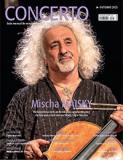
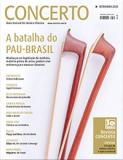
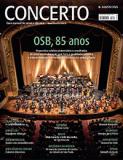
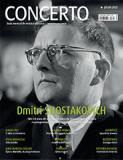

Comentários
Os comentários são de responsabilidade de seus autores e não refletem a opinião da Revista CONCERTO.